Tearing out awful juniper and replacing with low maintenance bed...
Resource Art & Design
11 years ago
My son and daughter-in-law (non-gardeners) have just bought a nice 50's bank-owned ranch in a suburb of Portland, OR. Lots of deferred maintenance issues that they will spend $$ on first. But, with the curb appeal at zero due to overgrown junipers, they do want to tackle pulling them out. Once out, we are looking for suggestions for low maintenance plantings with a contemporary, mid-century flair. As you look straight on at the house from the street, the garage (or east end) gets the most sun while the bedroom (west end) gets more shade due to the neighbor's incredible stand of Doug firs. The house faces north but the planting bed is so far out from the house that there is morning and afternoon sun on most of it. I was thinking some clumping grasses (maybe Karl Foerster since it doesn't require staking), an upright rosemary (Arp - pale gray foliage), some hostas in blue-green foliage at the shadier end and then some creeping phlox or wooly thyme to run over the lava rock that fronts the sloping bed. And probably a Japanese maple ('bout 15' at maturity) at one end or the other. BTW, the brick planter jutting out at far end of walk will be removed and the rhododendrons beyond it pruned back, the remaining brick façade will be painted a darker grey/charcoal, the sinking walkway will be replaced, the turned posts will be replaced with square ones and the roof, when replaced, will include skylights in the overhang to let light into the living room (cheaper than true skylights inside). And that lamppost will either be relocated or replaced. Any thoughts on the landscaping appreciated!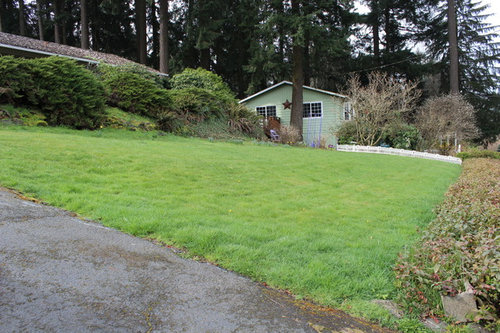
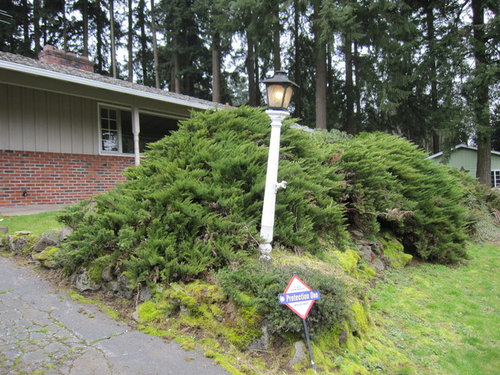
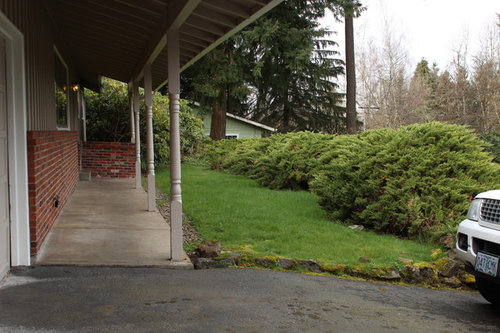



Featured Answer
Sort by:Oldest
Comments (25)
Resource Art & Design
Original Author11 years agoOne of the issues with the junipers is that when you look inside them, there is no growth except at the top so cutting them to one or even two feet would still leave stumps with no growth that I'm not sure would ever recover (they are at least 4'tall, growing on that slope). Starting in the 50's, junipers were very popular because they were low maintenance but then, they became NO maintenance for decades and homeowners around here abhor them now since they are practically a mark of neglect...great green lumps that have that unpleasant smell. One of the first things the guy across the street asked was, "are you going to do something with those junipers?". So they are fated to go. There's lots of new, low-growing conifers and evergreens that can give beds structure instead of these behemoths. The interiors are contracted with the lender to be done within 90 days so would prefer to get some simple things growing outside sooner rather than later. Of course all vegetation grows, especially in Oregon, so all plants going in will be 4" to 2 gallon size to save money. Especially want to concentrate on items that won't require lots of pruning, constant feeding and bug control. This property is .4 acre so it's not as if these kids don't know that there will be maintenance; they are firm that they are in it for the long haul. We have agreed to choose our battles with this yard and comply with their request to improve the curb appeal a bit. So are starting with possibly the most difficult task outside while they keep an eye on the contractors who will be working on new roofing, a new rear patio and other electrical/plumbing issues. Am attaching other pix of property... Any color suggestions for painting the brick or giving the front door some zing? The bank had the house painted so the body color is neutral enough to work with as is.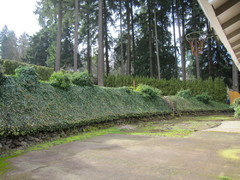
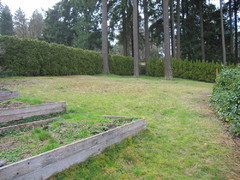
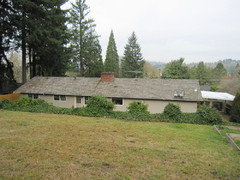
Related Professionals
Sweetwater Interior Designers & Decorators · Whitman Interior Designers & Decorators · North Chicago Architects & Building Designers · East Peoria Kitchen & Bathroom Designers · Philadelphia Kitchen & Bathroom Designers · Portland Kitchen & Bathroom Designers · Ridgewood Kitchen & Bathroom Designers · Dallas Furniture & Accessories · Phoenix Furniture & Accessories · Richfield Furniture & Accessories · Sugar Hill Furniture & Accessories · Dorchester Center General Contractors · Niles General Contractors · Selma General Contractors · Vermillion General Contractorsrinked
11 years agoThat sure is nice of you. And I understand you want to take the bushes out (I didn't know they're smelly). Wish you loads of succes doing so!
I like the brick. :) But I'm dutch, we are used to brick because nearly all houses in the Netherlands are made of brick.Rare Bird
11 years agoI cant advise on plants as I dont live in ur zone and i agree those plants have to go U have a lovely sloping aspect so I think Put pavers out to the edge of the existing to make a nice seating areaand use the slope to create a large rockery /shrubbery. U could use large trees around the plot and extra shrubberies.....Plants take years to grow so the outside is nearly more important than the inside where painting and decor are instant impact go to a local nursary to learn what plants thrive in ur area. U could possibly terrace the garden if the slope is deeply inclined good luckResource Art & Design
Original Author11 years agore the brick: I know...different generation :-} The skinny raw brick does date the house and they want what's now the modern concept of mid-century. It will be handsome in time; they have good ideas. We two sets of parents are being very careful to help only when asked ...it's their house, their plans. Is interesting to daydream about what to do with the various areas...top grassy area, back patio, front yard.Katherine D
11 years agoThe nice thing about the junipers at the moment is that they create privacy. Don't really like the thought of everyone being able to watch you in your own home. If, as you say, they have to be removed, I would replace with something that will block the public view. I like to break down the garden as a grouping of "rooms" with special interest in every section. An unexpected rock garden in one corner or a gazebo tucked in amongst a tree grouping. Love the wildlife, so anything that will attract the hummingbirds, butterflies, others. I let wild violets go to seed and they have spread throughout the garden popping up in the lawn and in the flower beds, even under my cedars! They are blooming right now and are just incredible! A carpet of purple!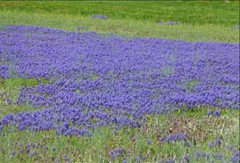
Resource Art & Design
Original Author11 years agoWas thinking maybe a bit of rockery on the side of the driveway where there is some terracing begun. Currently in this area, there is an evergreen (cedar, I believe) and some boxwood that line the drive. I think the boxwood was to lend some formality but instead they seem to cut the bed off from the rest of the yard so am thinking of replanting them on the neighbor side of the bed to "reclaim" that area back into the property. Then, whatever the tall, deciduous thing is (sumac?)...either pulling it out or replanting somewhere they need some height. Right now, it looks like something that accidently grew from seed where dropped by a bird.Katherine D
11 years agoLove rock gardens, and transplanting things. If it looks out of place, there is usually a spot where it will look fantastic. Try turning rocks on their edge, making them tall rather than flat for more sculptural feel.Resource Art & Design
Original Author11 years agoForgot to add pictures of this side of driveway bed on the side of driveway... here they are.... Just so many areas on the property to work on, will restrict to front house curb appeal first.
Realize removing junipers will open house to public view but it's high enough above street, some privacy will be maintained just due to the height above roadway which is fortunately a minor street. In the future, a decorative fence with horizontal slats in this area might be nice. Or maybe vertical slats to break up horizontal lines of the house, might be better. Any thoughts on fence - vertical vs horizontal?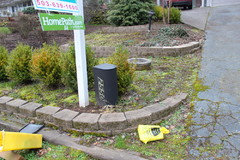
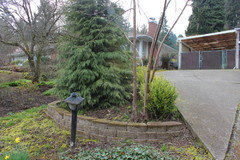
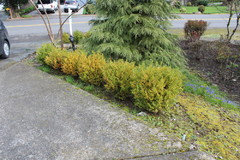
wanderbug
11 years agoI"m also in the greater Portland area so I thought I'd pop in to offer a bit of moral support (well, kind of, anyhow!).
Yes, the junipers HAVE to go! For those of you not in this area-trust me, she is right. Every single midcentury or older neighborhood in both Seattle AND Portland are overburdened with LOTS of juniper. It's like the landscapers from that era only knew about cotoneaster and junipers.
They are all monstrous, overgrown, with decades of bad pruning hidden in the top growth-and prickly besides. Plus, huge root systems that can be a bear to deal with, and on occasion, raccoon nests underneath.
The property overall is really nicely laid out. You'll have loads of options! I hope they tackle the ivy removal next.
I think the side of the driveway, while weedy, seems less dated than the rest. Maybe just start by cleaning up the weeds and/or getting a really nice large pot and putting down mulch or gravel would spiff that up enough to hold them through tackling the junipers and other larger stuff Although some nice blue fescues would look nice too.
What sort of watering systems are in place? That makes a difference, particularly along the street. If there isn't any, planning that system out to work on after you rip out the old stuff would be a good place to start.
Also, any idea how the soil is? Presumably it's acidic, but it is in good shape or heavy clay, or????wanderbug
11 years agoHow wide is the grass area between the walkway to the door and the junipers? I'm guessing the junipers are the typical 6ft(ish) diameter ones?
Are the new homeowners interested in becoming gardeners or would they rather get something set up and then just do the basics? It sounds like they're willing to do normal maintenance but so far want to keep things simple?
How familiar are you with gardening here? Are you also local/regional?Resource Art & Design
Original Author11 years agoI am local...currently live in Beaverton after 23 years in Raleigh Hills. Our kids' (son & daughter-in-law) house is in Lake Oswego. Frankly, it's a bit of a neighborhood eyesore so would like to do what they can (financially) to spiff up the street side. Currently no sprinkler system. Fortunately, my husband has put in several so that will be his and our son's job, after organizing a fence (backyard is partially fenced) for the dog and then pulling out the junipers. The soil I imagine is tired out (since I doubt any real gardener has ever lived in this house) with clay underneath. So, we'll need to amend it. Read an article by a local landscape designer saying she added compost and some quarter ten gravel to a new bed she was creating but think we might skip the gravel since, on the slope, I don't see any drainage issues. I do see a rototiller in our future.... The good news is, the yard's really a blank slate.
The juniper bed is about 9' from lower front to upper back and runs about 60' long. Rather daunting, now that I really see that written! The grass strip above it, from front walk to juniper bed is 10' and runs about the same length as juniper bed, petering out at the west end due to shade from neighbor's firs.
I like your blue fescue idea...that reminds me that there is a blue oat grass that might be good due to its larger scale.
Regarding are they gardeners...at 26 and busy with their careers, No, they definitely aren't gardeners. But I asked my son what he was most excited about getting started on with the new house and he said "the yard". WHAT? This from the kid I could barely get to help me spread compost ten years ago? Of course...since now this is HIS HOUSE :-} Makes all the difference! So will gather all your low maintenance and creative ideas and let them run with them. Many hands (brains) make light work, at least in the ideas category.Triangle Brick Company
11 years agoAs a brick manufacturer, we love the look of natural brick and its durability. However, if you do decide to paint the brick, please be prepared for increased maintenance. According to The Brick Industry Association, “Most paint authorities agree that, once painted, exterior masonry will require repainting every three to five years.”Resource Art & Design
Original Author11 years agoYep. Aware of that. We'll wait, of course, to our lowest humidity time - August, here in the NW and use a good masonry/brick paint. It should hold up pretty well since this particular area has such a large overhang. I don't believe it will receive excessive weather since most of our storms come from the south (this area faces north) and I'm not sure it ever gets much direct sun...maybe very LATE on summer afternoons/early evenings. Thanks for the input.wanderbug
11 years agoLk. Oswego is a lovely area! I'm actually up in WA. We moved down here from Seattle better than 10 years ago and at the time needed a convenient commute to the PDX area and stayed.
Yes, 60 ft long bank of VW-sized junipers IS a bit daunting-ugh!
However, more good news is that while you have VW sized junipers I do not see blackberry, horsetail or bindweed! That means it hasn't gone that long totally without basic maintenance. :)
Another plus is that while a blank slate, it's not totally blank. The existing lawn will be keeping weeds from colonizing everywhere while they work on it. So they can go in stages, particularly in the back. Boring is so much better than infested weed forest! ;)
It's great about the new patio! Will it be poured concrete, stamped concrete, pavers, stone slab? If it's colored, what color will it be?
Happy to hear you'll be pruning the rhodies and taking out the brick planter as well. I like the idea of the light wells and new posts. I've got some very talented gardening friends who have actually moved rhodies that big, so it can be done if you want to open up the space a little. How close are the Doug firs? Close enough for heavy needle drop or close enough to be shady but not too bad? That'll be something to keep in mind as far as the maintenance goes.
It sounds like from the top of the juniper rockery to the edge of the existing walkway that you have almost 20ft x 60ft? Plus the width of the walkway. Will they be taking out the lawn there also? That is plenty of space for a really nice courtyard/patio out front as well as a wider path.
I'm kind of new to Houzz but I'm going to try and attach a couple of pictures I found of long walkway/courtyard areas. With all that space you could really do some nice things there.
[img][/img] fresh and clean · More Info
fresh and clean · More Info
[img][/img]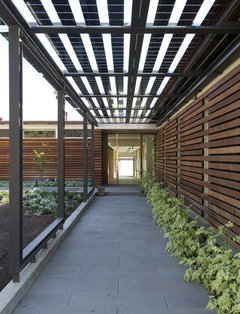 Jensen Architects · More Info
Jensen Architects · More Info
LOL on your son suddenly being interested in the garden. It's a pretty great time to start, lots of creativity these days. I'm just a gardening geek, no professional, but I do love garden transformations! I hope I can come up with some good ideas. I like this sort of midcentury house with the wide overhangs-to me it's kind of the "true" PNW style. A little nod to Asian, natural, not fussy, versatile.
It's great that your son and husband can put in a watering system. That makes so much difference, and it's a great DIY. too. You're probably right about not needing gravel for drainage in the front.Still, you won't know until you dig into it. Maybe when you get to the upper area in the back you'll want to use it to control where and how water goes downhill.
Kind of funny, my run-ins with those type of junipers as a kid have had me be anti-prickly-anything my whole adult life. ;)Resource Art & Design
Original Author11 years agoWanderbug - Yes, surprisingly little blackberry in general.
The grass from front walk to junipers (love the VW comment!) is 10'. Your photos are handsome so will keep them in mind for the future. Suspect they will first be concentrating on creating a "lounging" space in the back and just try to get planting areas in front figured out for now. The new patio in backyard will be 20' by 27' approx., centering on the window in back which is kitchen eating area inside. Don't know they've given much thought to WHAT to do in design of it. They were able to include a new patio in their financing since the existing patio, after 50 years, was slightly sinking toward the house. The new patio will be a cement product...perhaps just laid in a large squares pattern. Such a large area has to have "segments"...don't know what that would be called...joints? Just enough pattern to keep it from cracking but not enough get into realm of "fancy" or expensive. What do people think? Plain brushed cement or aggregate? Not sure what the style is now when one is doing contemporary patios. I suggested down the road they could eventually do some rectangular, raised planters (could clad them in horizontal, stained slats), maybe incorporating some clean-lined benches (daughter-in-law has mentioned she likes that look) thus tying the back in with any privacy fencing they might put in near front door. Plants in pots will have to do for time being on new back patio.
When we rent the trencher for the sprinkler system, we'll be laying in a French drain at the base of the ivy slope in back to help divert water from the house to the sides of the property. Any hints on constructing French drains? The drain pipes on the back of the house were missing! So once those get repaired and some additional drainage put in, I think the water won't be such an issue. The house is located right between a "moderate" to "low" earthquake hazard area so that's hopeful. I purposefully steered them away from houses built in what I call "jello" areas.
We also suggested they run a pipe under the new patio as a holding space out toward the ivy slope in case they eventually want to have a gas BBQ or fireplace out there.
The Douglas Firs begin immediately at the property line and fill the neighbors property of about 1/2 acre so the needles are definitely acidifying the soil. But, except in tight-squeeze suburbia where all trees have been removed to provide a blank slate, it's hard to get away from their effect here in NW, as you know. But it keeps the rhoddies, azaleas, etc. happy so you just have to amend for other items.
Both front and back lawns have quite a bit of moss. Anyone know of a grass that does better in shade? We'll treat for the moss then thought we might over seed, adding a grass more shade tolerant...is there one?
I know lawns are going out of style but for now and in the homeowners' stage of life, I think both expansive lawn areas are here to stay for a while.
KatherineD - I've always torn out the blue violets that have sprouted in my yard...just seemed they had the potential to be such a nuisance. But now one has entered my yard that has a larger bloom and is more of a pink blossom...it looks like an actual plant rather than a weed with a tiny blossom. I can see how you like them - especially in that picture with the large drift of them. After the cement blocks to the side of the driveway and lava rock (ick!) at the bottom of the juniper bed get power-washed, I hope the creeping phlox (blue-ish lavender color) cascading over them will look good. Also thought some wooly thyme mixed in will add color at another time of the year. Thought we might come up with some dark red plants to mix in front juniper bed to tie lava rock in...maybe heuchera? Any thoughts of something low maintenance? Other than the blossoms that shoot up from huechera that eventually should be cut back, the foliage is low maintenance.wanderbug
11 years agoI *think* exposed aggregate patios are currently out of fashion. Some people are doing stamped-texture stuff but I'm not sure where that falls in between in and unfashionable. I've seen mixed comments on that. Seems most of the high-end patio garden design pictures I see are a nice smooth gray color, often in large squares or rectangles. So the panel style with expansion joints should be fine-and easier to change out later, too, perhaps, if they change their minds.
The best thing we've ever done for our lawn is twice yearly over seeding combined with heavier fall fertilizing and a lighter spring plus once to twice yearly spreading of about an inch layer of a good compost mixture over all of it. (and of course lime/gypsum). We've had good results with a shade lawn mix that I think we bought at Portland Nursery. It's from a local company (can't remember who), but I think it makes sense to get a local-blended mix to suit our conditions. I'm sure some of the closer nurseries to you also carry it. I'm not sure if we have any left but I'll check with my husband (the lawn is his thing) and let you know the brand if we have any.
Doug firs are both a blessing and a pain. We've also chosen to not fight the under-tree stuff in a few spots and just backed the lawn out and widen the bed areas to a point where the lawn was reseeding in nicely. I also chose to put in a bed of mostly natives near the Dougs-the better to adapt, and that worked OK, too. I put in a grouping of Vine maples and ferns and added hellebores (not native, of course) as well. They were a bit slow to settle in but now are doing well. They're more drought-tolerant than many people realize. My one regret is that I put dark red ones instead of cream or yellow.
I adore Heuchera! I was up to quite a collection of them before I dialed back my plant collecting habits.
IF the area with the lava rock (I agree, not a favorite of mine either, but understand it's one thing at a time) is pretty dry-and with the slope it can be, you could choose to treat it sort of like a rock garden, with plants that tolerate or thrive in lower water conditions such as lavender, agastache, some of the pennisetum grasses are pretty durable and there are some lovely reddish ones. Plus there are sedums, sempervivums (hens and chicks)-these are going through a very popular phase right now, too. Some of them are quite enthusiastic growers, though.
Great idea to run a gas line into the patio while they've got the chance.Resource Art & Design
Original Author11 years agowanderbug -Think you're right about aggregate these days. Lots of great plant suggestions above. As I have aged, I have learned that foliage can bring color into the garden and it will last longer than flowers. So I, too, have succumbed to the wiles of heuchera...my current favorite I just found is called Black Out...very dark but with VERY shiny leaves. Just great!
My garden club members and I visited a gal near Washington Square shopping mall that was a daylily grower and who was going out of business. She let us have a ton of her daylilies for our annual plant sale (was a couple years ago, now) and while visiting her lovely yard, noticed that she had pretty ceramic pots of plants mixed in with her perennials. Why the pots? we tactfully asked. She said some of the roots of her trees grew close to the surface and she couldn't get plants in the ground there, leaving holes in her beds. So she put plants in pots that went with the surrounding foliage/blossoms. It made great sense so I did the same thing cuz I have three maples in front of my house and their roots are something else. So, for areas under good-sized trees, if people want a full looking bed, then I suggest adding a potted plant or two. You can go "low" and add unobtrusive short pots or go "big" and add brightly colored ones that will complement the neighboring blossoms. Not too many, tho, or things will start looking like Ma & Pa Kettle live there - too busy. The caveat is, of course, unless you have a drip system onto which you can add the pots, you will have to individually water them.wanderbug
11 years agoHi,
I agree, I love large statement potswhether neutral or bright--and yes it is easy to go overboard but when done right it's wonderful. There is a house I drive by frequently that has clutter overload in rows and rows of scattered pots everywhere-ugh!. That said, she does have loads of flowers and must be a pretty good gardener to keep them all healthy and happy.
I've been trying for days to remember something I once knew about heucheras. I suppose you know they're predominantly north American native plants and there's something like 6 families of them throughout the country. Lots of the new breeding has involved crossing the different families (to get stunners like BlackOut and all the other colored ones). It seems though that some folks find certain families more durable, sun tolerant, and longer lived than others. I know some of them are considerably harder to keep happy than others-Obsidian, for instance -may even be gone from the trade now as it was so fussy plus it was a lot like Blackout. That one either thrived or died. Anyway, I wanted to tell you which families to be scouting for if you went in for a row of them and it's totally gone from my brain. :( I don't even remember where I found the information in the first place. Dan Heims of Terra Nova did write a book about them-maybe that's where I saw it.Ironwood Builders
11 years agolast modified: 11 years agoI'm in sunny and dry summer California, north of SF...but was thinking a good native ground cover like the mini blue flowered ceanothus (aka California lilac) would be a good choice. Hardy in our Zone 2 climate.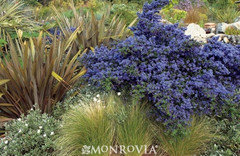
Resource Art & Design
Original Author11 years agoWe do "do" ceanothus up here. Wonderful source of true blue in the yard. Had forgotten about it! Nice, too, cuz it's evergreen. Thanks for the suggestion and like the picture...good composition. There's one that's very ground hugging, too, with tiny little leaves that almost look like little holly leaves. Can't remember the name, tho. There will be lots of ground to cover in this yard so both types might be useful. Thx!bellafiore
7 years agoIf they want low maintenance, definitely do a shrub border...you can put perennials in between until the shrubs grow together...then they can be removed. Or just put groundcover in between. But perennials (like heuchera) need to be divided every few years and it can be a lot of work. Some perennials can go a lot longer without division to retain bloom, etc. But I like the "native" idea that Ironwood Builders suggested. Love that prairie look. Good for the wildlife, birds, butterflies, etc. Of course, rhodies, azaleas and fuchsia are always wonderful for color.
Related Stories
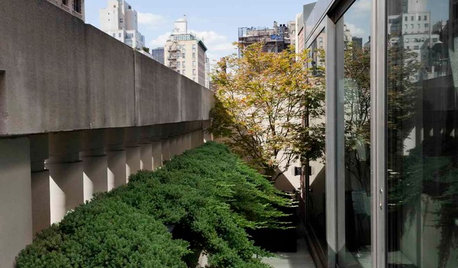
GARDENING GUIDESGreat Design Plant: Creeping Juniper Holds Its Ground
Add texture and evergreen interest to a layered garden with this low-maintenance, good-looking ground cover
Full Story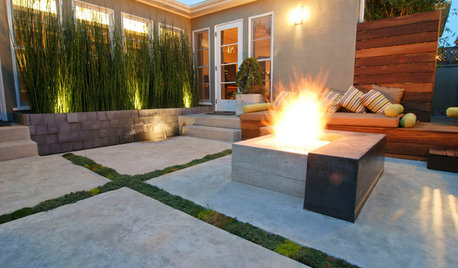
GREAT HOME PROJECTSHow to Tear Down That Concrete Patio
Clear the path for plantings or a more modern patio design by demolishing all or part of the concrete in your yard
Full Story
REMODELING GUIDESWhat to Know Before You Tear Down That Wall
Great Home Projects: Opening up a room? Learn who to hire, what it’ll cost and how long it will take
Full Story
GREAT HOME PROJECTSHow to Replace Your Lawn With a Garden
New project for a new year: Lose the turfgrass for energy savings, wildlife friendliness and lower maintenance
Full Story
MONTHLY HOME CHECKLISTSYour Fall Home Maintenance Checklist
Prep your house and yard for cold weather with this list of things to do in an hour or over a weekend
Full Story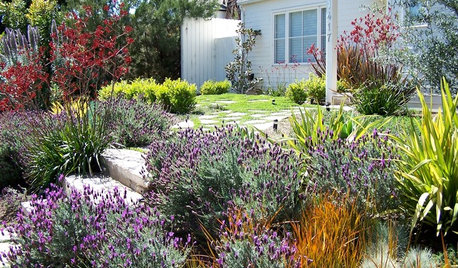
SAVING WATERGreat Plants for Lush, Low-Water Gardens
Water restrictions making your garden look washed out? Give it living color with unthirsty grasses, flowers and succulents
Full Story
MOST POPULARMeet a Lawn Alternative That Works Wonders
Carex can replace turfgrass in any spot, is low maintenance and adjusts easily. Add its good looks and you’ve got a ground cover winner
Full Story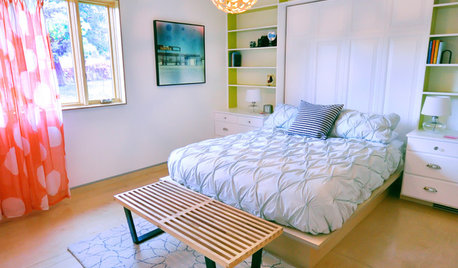
WOODTry DIY Plywood Flooring for High Gloss, Low Cost
Yup, you heard right. Laid down and shined up, plywood can run with the big flooring boys at an affordable price
Full Story
GRASSES10 Ways to Use Ornamental Grasses in the Landscape
These low-maintenance plants can add beauty, texture and privacy to any size garden
Full Story
GARDENING GUIDESWhat Are Your Spring Gardening Plans?
Tearing out the lawn? Planting edibles? Starting from scratch? Tell us what you plan to change in your garden this year
Full Story







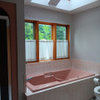

rinked